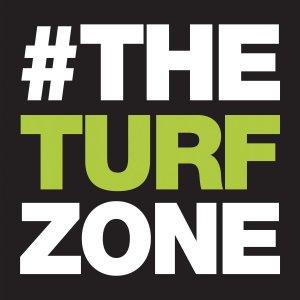The Turf Zone Podcast

Pennsylvania Turfgrass Council – Dissecting Infield Playability
Pennsylvania Turfgrass – Evan C. Mascitti and Andrew McNitt, PhD
A baseball often touches two different surfaces during the same play. This sets baseball apart from other ball sports. Most ground balls take their first bounce on the turf and are fielded on the infield skin (Figure 1). The concentration of play in this small area means that infield playability consumes much of the grounds crew’s focus. Experienced managers know instinctively when the ball is reacting the way they want, and they can produce a consistent surface despite changing weather conditions. Playability can be an ambiguous term because it is easy to observe but hard to describe.
This article unpacks infield playability by combining practical observations with bite-size pieces of physics. We will cover the following ideas:
1. Consistency is king
2. Components of speed
3. Corkboard = plasticity + stiffness
Consistency is king
Above all else, infielders want a consistent, predictable surface. This means no surprises about how the ball will react from one hop to the next, and that the field will play identically throughout a game and over the season. Elite athletes can field almost any ball, fast or slow – so long as the bounces are the same, each and every time. Infielders prefer ground balls to “hug” the surface: a shallow path makes the ball easier to track and collect. The grass and dirt areas should have similar speed and the transition between them should be seamless.
Predictability is crucial for players to be able to do their jobs. If the final hop is deflected by just a few degrees, the ball can easily carom off the heel of a player’s glove or scoot beyond his reach.
Components of speed
Players and coaches sometimes ask us to “speed up” or “slow down” the infield, usually by adjusting the cutting height of the turf. Ball response is more nuanced than fast vs. slow, and canopy height plays only a minor role. However, it has been said that perception is reality, so a perceived change may satisfy such a request – even if we fib about having lowered the reels by 1/8″ or so. Ball response is divisible into three important elements: pace, bounce, and spin.
Pace
Pace is the relative velocity of a ball after impact. Infield pace is mostly determined by hardness and friction. It is measured as a simple ratio, the Coefficient of Restitution (COR):
There is limited research on infield pace, but data suggest that soil properties affect COR more than cutting height or thatch. Dr. Jim Brosnan measured COR on real infields and on research plots (Brosnan and McNitt, 2008a; b; 2011). Infield COR ranged from 0.4 to 0.6, meaning a ball retained 40 to 60 % of its initial velocity after the first bounce. COR was generally higher on skinned surfaces than synthetic turf, which had a similar (but slightly higher) COR than natural grass.
In the work by Dr. Brosnan, pace was closely related to surface hardness. Hardness is easy to measure with the familiar Clegg hammer or the F-355 device (for synthetic infields). Brosnan and McNitt (2008a) found that most infield skins had Clegg values well over 100 Gmax – much higher than values recommended for turf areas (Figure 2). However, it is worth noting that some fields in this study were substantially drier than typical game moisture. In a baseball context, hardness may be more useful for managing playability than safety, as baseball players are never tackled and rarely become injured by falling on the surface.
Ball-to-surface friction is determined by soil texture, presence of conditioner, and the all-important water content (Goodall et al., 2005). A thick conditioner layer reduces surface friction because the granules rotate like ball bearings as the ball shears against them. The ball will skid rather than checking up. Friction also affects the ball’s release angle, which in turn alters the bounce height (Figure 3).






 Visit Podcast Website
Visit Podcast Website RSS Podcast Feed
RSS Podcast Feed Subscribe
Subscribe
 Add to MyCast
Add to MyCast